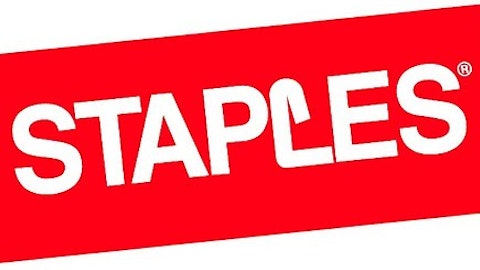
A great first quarter, and more to come
The TJX Companies, Inc. (NYSE:TJX) posted a great first quarter of FY 2014 (which is the first quarter of calendar 2013), with EPS growing by over 10% (from $0.55 to $0.62) and comps by 2% year-over-year. Management is returning value to shareholders, with $1.3 billion to $1.4 billion in share repurchases planned for the remainder of FY 2014, and a recent quarterly dividend hike from $0.115 to $0.145 (the 17th year in a row that the dividend has increased). With a payout ratio below 25%, there is plenty of room for the dividend to grow even if earnings don’t.
But I expect earnings to grow. On the first-quarter 2014 earnings call, CEO Carol Meyrowitz noted that: “We see the potential to grow our store base by at least 50% with our current portfolio in our current markets alone.” Interestingly, with Europe a black hole for many other American companies (see:Ford Motor Company (NYSE:F)), The TJX Companies, Inc. (NYSE:TJX) views the continent as a big opportunity for growth. Management believes the discount-retail model will continue to perform in Europe and, given the economic malaise, I think they’re right. When people have less to spend, they’re looking for a bargain – and The TJX Companies, Inc. (NYSE:TJX) is the biggest discount retailer in Europe.
Different from other retailers
A lot of retailers are playing defense against Amazon.com, Inc. (NASDAQ:AMZN), which grew revenue an astonishing 318% between 2008 and 2012 by promoting “showrooming,” where customers test-drive products at traditional brick-and-mortar stores and then buy them cheaper online. While Amazon.com, Inc. (NASDAQ:AMZN) has been a major disruptive force in the retail market, I don’t see it as a threat to TJX for two reasons, one immediate and one long-term.
The immediate reason for my lack of concern is that there is limited product crossover – only 17% of The TJX Companies, Inc. (NYSE:TJX) products can also be found on Amazon.com, Inc. (NASDAQ:AMZN) compared to 46% of the average retailer’s inventory. Long term, Amazon.com, Inc. (NASDAQ:AMZN) has to remain profitable to continue to remain in investors’ good graces. Amazon.com, Inc. (NASDAQ:AMZN)’s EPS went negative at the end of 2012, and the first quarter of 2013 showed a substantial decline in earnings from the first quarter of 2012 ($0.18 versus $0.28). Amazon will have to raise prices at some point – volume alone will not make up the deficit.
I do not think Amazon will feel that pressure to turn around earnings yet – management is strengthening the Amazon universe with offerings like Amazon Prime and Amazon Mom – but, long term, margins will have to increase. As retailers become increasingly savvy to Amazon’s practices, they will also make Amazon’s continued expansion more difficult.
E-commerce
TJX doesn’t have an e-commerce website, although there are plans to unveil one by the end of FY 2014. TJX recently acquired Sierra Trading Post, a small off-price retailer with an e-commerce store, for $200 million in an all-cash deal. Management will leverage Sierra Trading Post’s knowledge base to instruct TJX’s expansion online. While this will bring TJX into the same arena as Amazon (online shopping), I still believe that there will not be significant competition due to the different product lines offered.
The major competition
By many metrics, Ross would seem better than TJX. For the trailing-12 months, Ross reported a better operating margin (13.2% compared to TJX’s 12.0%) and a lower P/E ratio (18.2 versus 20.0 for TJX). Ross sports slightly faster EPS growth (15% growth for the most recent quarter compared to 13% at TJX) and a lower debt-to-equity ratio (0.1 compared to 0.3). They pay roughly equivalent dividends (yielding about 1% each).
However, it’s the disruptive innovation that will make a difference here. Neither Ross Stores, Inc. (NASDAQ:ROST) nor TJX has an e-commerce website, but TJX has plans to implement one (unlike Ross, which is examining the idea but has made no commitments). TJX is increasing market share internationally, while Ross Stores, Inc. (NASDAQ:ROST) remains US-centric. TJX’s increasing geographic dispersion will enable the chain to better weather an economic downturn in one country by bolstering sales in others – Ross Stores, Inc. (NASDAQ:ROST) is wholly dependent on the United States.
Foolish conclusion
TJX, like Ross Stores, Inc. (NASDAQ:ROST), has a great business model, which works well in good and bad economic times. Unlike Ross Stores, Inc. (NASDAQ:ROST), management is not resting on its laurels but is rather expanding and changing the model to make it more accessible at home and abroad. With Amazon only a distant threat at most, TJX is a great long-term investment for your portfolio.
Michael Douglass has no position in any stocks mentioned. The Motley Fool recommends Amazon.com. The Motley Fool owns shares of Amazon.com. Michael is a member of The Motley Fool Blog Network — entries represent the personal opinion of the blogger and are not formally edited.
The article Buy This Discount Retailer originally appeared on Fool.com is written by Michael Douglass.
Copyright © 1995 – 2013 The Motley Fool, LLC. All rights reserved. The Motley Fool has a disclosure policy.




